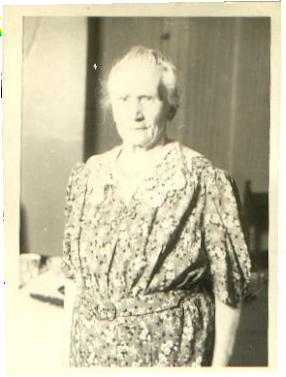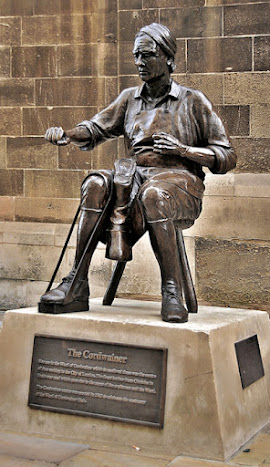Frank Vokoun - The Sharp-dressed Man
Every girl crazy for...
No I'm not going to link the video. I like ZZ Top and I liked the song when first released but it now falls into my personal list of songs that I would give a year of my life to never hear again. I'm sure it is playing in your head already. It does seem like a good theme song for our family of tailors. This is about the oldest.
Frantisek Vokoun was born in 1858 in Královice house #15 and was actually the second child for Jan Vokoun and Anna Bechyne. The first, Vaclav, died as an infant. The next record for him after his birth record is the 1880 census when he was 22 years old. His immigration year is unclear. Most of the family arrived in 1875 or 1876 based on the birth locations of one child who died born in 1874 in Bohemia and, subsequently, the youngest, Joseph Edward, born in 1876 in Chicago. But Frantisek might be the exception. Some census records and voter registration records suggest he might have arrived as early as 1871 at the age of 13 or 14. If he arrived in 1876, he would have had two years to meet and marry Josefa, move out of the house, and have his first born son. Seems like a tall order. Also he would have had family in Chicago in 1871 because his aunt, Marie Vokoun Novotny, immigrated about 1866.
 |
| 1880 Census (electronically listed as 'Vokonn') |
There is some confusion about his name. Obviously, Frantisek was 'Americanized' at some point. Also, he is not listed as having a middle name in his birth record. However, in the Chicago city directory, he is listed as Frank J. Furthermore, his son is Frank James. One of the descendant's has pointed out that he was named after Frank James but that the name should be Francis James. I have not found any record to clarify this. The census and city directories of the time use Frank for both the father and son. But I have found numerous errors in spelling in those records as well. The census workers just seemed to write down whatever the name sounded like to them. I'll continue to refer to Frantisek as Frank while acknowledging that he could well be Francis.
I have not been able to find out much about Josepha Chlup. She was born in Bohemia in 1861 to Joseph and Barbara Chlup. Joseph and Barbara are listed in the 1880 census as living alone on Burlington St. Barbara was born in Bohemia about 1824 and died in 1884. I showed the cemetery plot purchased by Frank for her in my post on the Bohemian National Cemetery. Joseph Chlup was born about 1810. He appears in the 1887 Chicago City directory at the Burlington address and again in 1892 at 606 Throop Street apparently living with Frank and Josepha until his death in 1900. Thus far, I have not found any other records for Chlups in Chicago. My guess is that they had daughters who were married with different names by 1880.
 |
| 1892 Chicago City Directory |
In 1880 Frank was the only sibling not living in the Forquer Street house. He, Josepha, and his son, Frank James Jr, who was one year old, were living at 162 DeKoven Street. DeKoven Street plays an important role in Chicago history. It was named for John DeKoven, one of the founders of the Northern Trust Company, one of the largest and oldest banking institutions in the United States. But that's not so special. Here's a hint:
The Chicago Fire of 1871 started in the barn behind the cottage of Patrick and Catherine O'Leary at 137 DeKoven Street. Frank and Josepha were just a few houses down the street from the spot. I'm afraid the question of whether they also had a barn in back will never be answered. What can be answered though is that fire insurance in the aftermath of the fire played a major role in the success of other family members. That is a story I will save for later.
 |
| Dekoven Street |
The popular story is that a cow kicked over a lantern to start the fire, a news reporter actually created the cow story and later admitted that he had made it up because he thought it would make for better copy. Talk about fake news. At the time, the street was in a less prosperous neighborhood of Chicago. Today the site is occupied by the Chicago Fire Academy and the address is the same as that where legend has it that Mrs. O'Leary's cow kicked over the lantern that started the Great Chicago Fire. Even if the story isn't true, it made for the best campfire song eveeerrr!
Between 1880 and 1900, daughters Anna (1882) and Julie (1885) had joined the family. Julie was baptized at St. Wenceslaus Catholic Church named after St. Wenceslaus, Duke of Bohemia. They also moved on from the 'fire hazard zone'. In 1900 Frank, Josie, Anna, and Julie were living at 606 Throop Street. Anna is 17 and working as a 'factory girl'. Frank Jr was on his own with his family.
 |
| 1900 census (electronically listed as "Vokorm") |
The 1910 census lists just Frank and Josepha at the address. Anna had married James Placek in 1904. Julie moved to Denver, Colorado where she married Rudolph Halama. She died in 1916 leaving a young daughter, Josephine. Julie's remains were brought back to the Bohemian National Cemetery. Rudolph lived until 1950 and had two more wives. He must have remained close to Julie in heart because, although dying in Denver, his remains were also returned to the BNC where he rests near Julie. Here is the picture that we have of Frank Jr., Anna, and Julie. We are not completely certain that Anna is on the left and Julie on the right.
 |
| Anna, Frank Jr, Julie Vokoun. |
Frank is the sharp-dressed man because he was a tailor, a gentlemen's tailor to be specific. He is listed in multiple years of the Chicago city directory. In the 1900 edition, Frank James, his son, is also listed as a cutter. He worked at time characterized by tremendous change in the manner in which clothing was made and sold. Before the advent of sewing machines (the first American sewing machine patent was granted in 1846), all clothes were cut and sewn by hand and tailored to the specific customer. The desired fit was achieved by tailors who created their patterns with methods that were their trade secret. They were not shared with apprentices until a master tailor handed over his business to someone who had bought it. Many fittings might be necessary.
 |
| Frank J - tailor and Frank J Jr - cutter |
Tailoring was typically a long-hour, low pay industry in the 19th century. Especially when all the garments were hand sewn. With the sewing machine and the rise of the department store that began to change. Most department stores had started out as drapers, and even in their expanded form most concentrated on the sale of clothing, shoes, millinery, fabrics, household textiles and furnishings. The establishment of workrooms for tailoring, dressmaking, millinery, upholstery and so on was thus a logical extension of the department stores’ services. The demand for more efficiency and better prices also led to the rise of generic sizing for clothing meaning that rather than create a specific cut for each customer, there were stock cuts for various sizes. Even
In the 1880s department stores began to open in Chicago. The best known was Marshall Field's which opened its doors in 1881. The development of the department store posed a serious threat to smaller retailers. Many small merchants tried to rally the public against the new behemoths, but they failed to gain much support. Rather than rally to the side of traditional merchants, Chicago shoppers embraced the new form of retail. I had imagined that department stores ran large tailor shops but it appears that initially they actually utilized many small home shops for clothes making.
In my first draft of this post, I didn't know much about Frank's tailor shop but I have since learned a surprising amount about his operation. It seems that there were thousands of tailors working from home in Chicago in the late 19th century. They would do work for the merchant tailors and department stores a like. Frank was this type of tailor. He ran his shop from his home on Throop Street. Here (p 260 of pdf file) is his main customer, A. Eisenbach.
It turns out that even tailors working from home were subject to inspections by the Factory Inspectors of Illinois. He appears in another of their annual reports along with brother, Charles Vokoun, who had his own home shop. Theirs are among nearly 4000 shops in the inspection report. The Factory Inspectors primary concerns were enforcing child labor laws, ensuring that homes did not violate zoning ordinances for spaces used both as living areas and work areas by non-tenants of the home, and reporting on overall cleanliness of the operation. We know that Frank ran a clean shop and that he had a male and female over age 16 working there in 1897, possibly Frank Jr and Anna.
A newspaper search for Frank Vokoun at the turn of the century reveals a crazy coincidence. In 1905 a Frank Vokoun, tailor, from Chicago made national news by attempting to murder his estranged wife by shooting through her closed apartment door before killing himself. This is NOT our Frank Vokoun but I mention it to clarify the record. There was at least one other Vokoun family in Chicago during this period and they may be more distantly related to Jan and Josefa Vokoun and their children. But at this time, I cannot definitively connect them.
Frank did die early, though. He passed in 1911 at the age of 52. Family tradition is that he died of appendicitis. Josepha would outlive him by an astonishing 45 years. She remarried to another tailor, Frank Bohdan (no, that's not a mistake), and lived out her life in Illinois. Frank Vokoun is buried in Montrose Cemetery which is across the street from the Bohemian National Cemetery where Josepha is buried. The family suspects this could be a photo of Frank Vokoun, although it could be Frank Bohdan.
 |
| Frank Vokoun or Frank Bohdan? |
 |
| Frank Bohdan and Josepha Chlup in 1914 |
Josepha liked to remind the family that she was married had two marriages that lasted over 25 years. Kuddos to her! Here is Josepha later in life
 |
| Josepha Chlup Vokoun Boldan |
Frank and Josefa have living descendants through Frank James and Bertha Vanderbiest Vokoun and through James and Anna Vokoun Placek. Frank Lilly has started a great blog about the Frank and Bert Vokoun family. I have not been able to find any children of Josephine Halama.
One final note, my son to my wife's great dismay has the unique style of, well, an 11 year-old boy. Picture fluorescent green shirt, bright red shorts, and black socks with reindeer prints no matter the time of year. Knowing that we had a tailor in the family, I can now tell my wife that my son clearly got his fashion sense from her side of the family!






Comments
Post a Comment